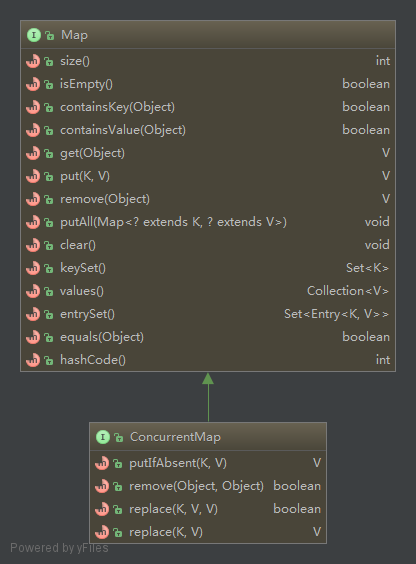1
2
3
4
5
6
7
8
9
10
11
12
13
14
15
16
17
18
19
20
21
22
23
24
25
26
27
28
29
30
31
32
33
34
35
36
37
38
39
40
41
42
43
44
45
46
47
48
49
50
51
52
53
54
55
56
57
58
59
60
61
62
63
64
65
66
67
68
69
70
71
72
73
74
75
76
77
78
79
80
81
82
83
84
85
86
87
88
89
90
91
92
93
94
95
96
97
98
99
100
101
102
103
104
105
106
107
108
109
110
111
112
113
114
115
116
117
|
final V put(K key, int hash, V value, boolean onlyIfAbsent) {
HashEntry<K,V> node = tryLock() ? null :
scanAndLockForPut(key, hash, value);
V oldValue;
try {
HashEntry<K,V>[] tab = table;
int index = (tab.length - 1) & hash; // 获取下标
HashEntry<K,V> first = entryAt(tab, index); //获取Segment的table[index]数组第一个HashEntry
for (HashEntry<K,V> e = first;;) { // 完成 HashEntry链表拼接,hash(key)相同(说明hash发生碰撞),key不相同。
if (e != null) {
K k;
if ((k = e.key) == key ||
(e.hash == hash && key.equals(k))) { // 判断key是否相等,
oldValue = e.value;
if (!onlyIfAbsent) { //判断是否有相同key,替换旧值
e.value = value;
++modCount;
}
break;
}
e = e.next;
}
else {
if (node != null)
node.setNext(first);//拼接next
else
node = new HashEntry<K,V>(hash, key, value, first);
int c = count + 1;
if (c > threshold && tab.length < MAXIMUM_CAPACITY)
rehash(node); // 扩容
else
setEntryAt(tab, index, node);//volatile写语义 赋值数组下标值
++modCount;
count = c;
oldValue = null;
break;
}
}
} finally {
unlock();
}
return oldValue;
}
/**
* Scans for a node containing given key while trying to
* acquire lock, creating and returning one if not found. Upon
* return, guarantees that lock is held. UNlike in most
* methods, calls to method equals are not screened: Since
* traversal speed doesn't matter, we might as well help warm
* up the associated code and accesses as well.
*扫描一个包含给定键的节点,同时尝试获取锁,创建和返回一个如果没有找到。在返回时,保证持有锁。
* 在大多数方法中,对方法的调用没有经过筛选:因为遍历速度并不重要,所以我们可以帮助对相关的代码和访问进行预热。
* @return a new node if key not found, else null
*/
private HashEntry<K,V> scanAndLockForPut(K key, int hash, V value) {
HashEntry<K,V> first = entryForHash(this, hash);
HashEntry<K,V> e = first;
HashEntry<K,V> node = null;
int retries = -1; // negative while locating node 负而定位节点 (重试次数)
while (!tryLock()) {
HashEntry<K,V> f; // to recheck first below
if (retries < 0) {
if (e == null) {
if (node == null) // speculatively create node
node = new HashEntry<K,V>(hash, key, value, null);
retries = 0;
}
else if (key.equals(e.key))
retries = 0;
else
e = e.next;
}
else if (++retries > MAX_SCAN_RETRIES) { // 重试次数大于最大次数,就用lock锁,
lock();
break;
}
else if ((retries & 1) == 0 &&
(f = entryForHash(this, hash)) != first) {
e = first = f; // re-traverse if entry changed 如果输入更改,则重新遍历
retries = -1;
}
}
return node;
}
/**
* Gets the table entry for the given segment and hash
* 获取给定段和散列的表条目
*/
@SuppressWarnings("unchecked")
static final <K,V> HashEntry<K,V> entryForHash(Segment<K,V> seg, int h) {
HashEntry<K,V>[] tab;
return (seg == null || (tab = seg.table) == null) ? null :
(HashEntry<K,V>) UNSAFE.getObjectVolatile
(tab, ((long)(((tab.length - 1) & h)) << TSHIFT) + TBASE);
}
/**
* Gets the ith element of given table (if nonnull) with volatile
* read semantics. Note: This is manually integrated into a few
* performance-sensitive methods to reduce call overhead.
* 获取给定表的第i个元素(如果是非空),具有volatile读取语义。注意:这是手动集成到一些性能敏感的方法,以减少调用开销。
*/
@SuppressWarnings("unchecked")
static final <K,V> HashEntry<K,V> entryAt(HashEntry<K,V>[] tab, int i) {
return (tab == null) ? null :
(HashEntry<K,V>) UNSAFE.getObjectVolatile
(tab, ((long)i << TSHIFT) + TBASE);
}
/**
* Sets the ith element of given table, with volatile write
* semantics. (See above about use of putOrderedObject.)
* 设置给定表的第i个元素,使用volatile写语义
*/
static final <K,V> void setEntryAt(HashEntry<K,V>[] tab, int i,
HashEntry<K,V> e) {
UNSAFE.putOrderedObject(tab, ((long)i << TSHIFT) + TBASE, e);
}
|

